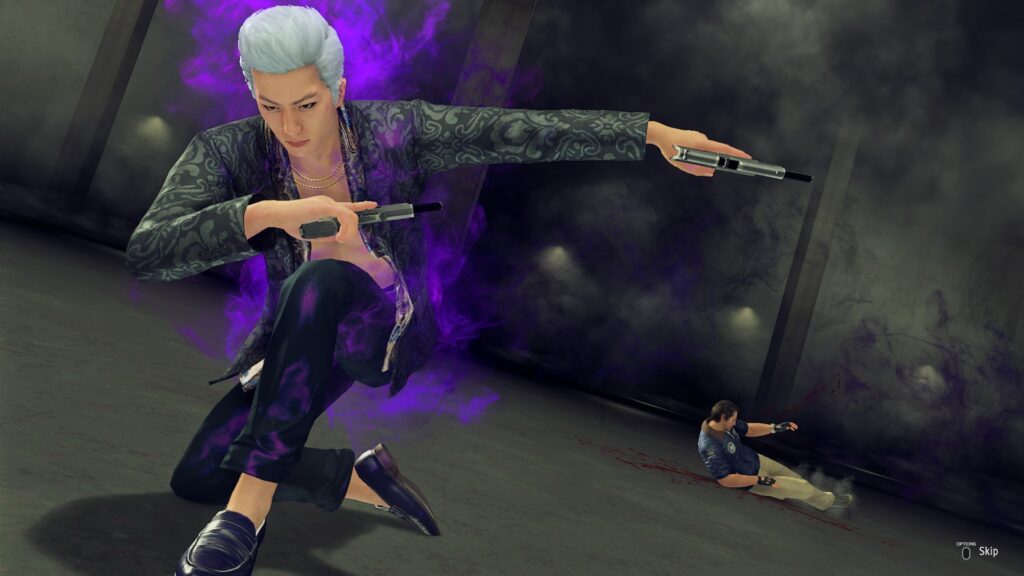Yakuza: Like a Dragon is a massive gamble for the long running Yakuza franchise. It is a sudden genre-shift, in a franchise otherwise content on reusing as much content as possible to save costs. Did this gamble work out though? Not for me, unfortunately.
Yakuza has, with one spin-off exception, been a series of open world beat-em-ups with a focus on a gritty narrative about the politics of the titular crime organization, contrasted by mundane and ridiculous stories of citizens of the cities of Kamurocho, or in this game, Yokohama. A beautiful city, thanks to the beautiful (but not very well optimized) Dragon Engine, helps separate this game further from the predecessors, not just by gameplay and characters, but also by location.

Except it doesn’t. Yakuza: LAD is still very much a traditional Yakuza game in every single way but the combat. Setpieces are designed very similarly to the previous games, substories follow much the same formula, and it’s all we’ve seen before, still in its very familiar form – and it was my favourite part.

I’m not a huge fan of jRPGs, but even I could tell something was a little off about the combat in LAD. It unfortunately isn’t really interesting – it lacks strategy. Every character in every job has one or two moves which are always superior to everything else, and while there absolutely are fights that keep you on your toes and require you to strategize – I could count them on one hand.
Counting one of these as “difficult” is kind of cheating, however. Around ¾ of the way through, there’s a fight that is just designed to kill you until you level up by a ridiculous amount. And I really do mean kill you – there is no way to avoid an attack that instakills you below level 50, while you are on level 30-35 when you enter the fight for the first time. What’s worse it comes completely out of nowhere – the game doesn’t warn you at all that this would be any different from a standard setpiece, which is just kind of ridiculous.

The same fight however hides a much bigger issue, however – as that fight is the point where the story starts going off the rails. It’s unfortunate, because just like with Yakuza 5, Like a Dragon has a very strong opener in this regard – it brings you into the mystery quick, and it gradually reveals more players in the intrigue, and just how complicated it all gets. It’s also surprisingly thematically consistent WITHOUT shoving the message in your face – you won’t be hearing “yume” every other line like in the aforementioned fifth installment.

What I also enjoyed a lot this time around was the side-content. The amount of substories has been significantly reduced if you’re coming from games like Kiwami 2 or Yakuza 0, and it matches Yakuza 6. But what it may lack in quantity, the side-content more than makes up for itself in the quality – Like a Dragon simply has one of the funniest and most charming substories in the series across the board – it’s very consistent in that regard, too, which I am really glad to be able to say.
Unlike the main story, some of the side-content actually utilizes the genre switch to turn-based jRPG. While the plot twists arrived and more layers to the intrigue were revealed, Yakuza’s famous 1 on 1 fights were often now 1 on 4s, and left me a huge feeling of dissatisfaction, thinking “what part of this game wouldn’t have worked better with a real-time brawling battle system?”, all the while the substories utilized the turn-based nature to a much greater effect, delivering fights that just wouldn’t at all be possible – or anywhere near as fun – had this been a traditional Yakuza game. Recent news of the game switching genres pretty late in its development only adds more doubt to the premise.

Ultimately, while Yakuza: Like a Dragon isn’t a bad game, it doesn’t quite come to the quality that the series’ veterans might expect. It’s plagued with tons of minor annoyances, a plot that falls apart, and a very clear lack of polish and experience with the genre. I think we will find that a lot of people, even those less critical than me, will find themselves wanting to go back to the previous games’ gameplay style.
A review copy was kindly provided to us by Sega.



